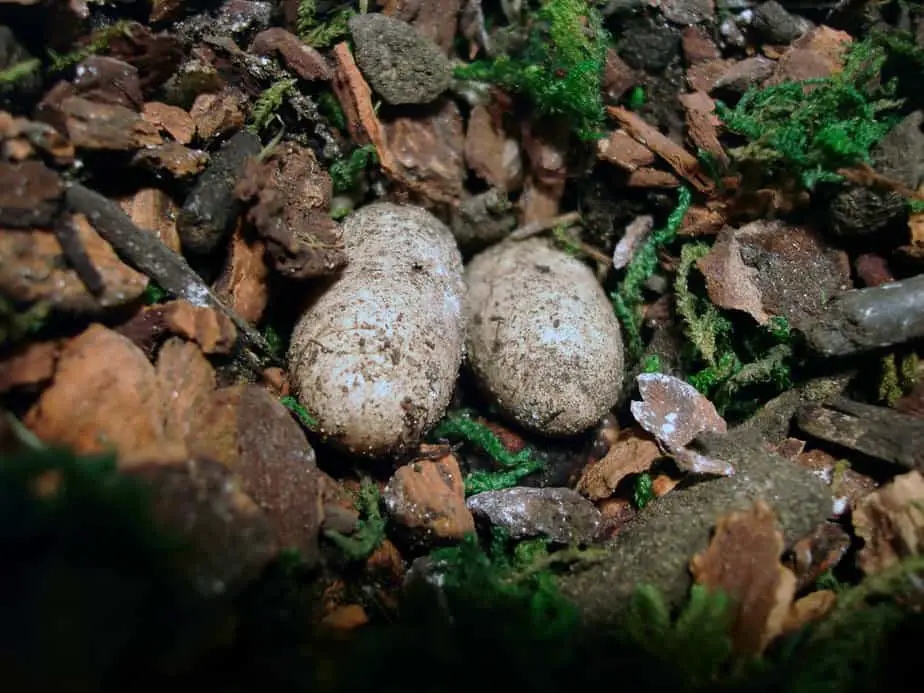Once a female leopard gecko reaches maturity, they start laying eggs regularly, even if they don’t mate. But how many eggs do leopard geckos lay?
Leopard geckos lay 8 to 10 eggs per year. One or two eggs at a time, around three to four times a year. These eggs are usually large, smooth, and measure approximately 35mm by 16mm. Female leopard geckos lay these eggs in dark and humid spots.

Can leopard geckos lay more than two eggs at once?
While leopard geckos mostly lay two eggs at once, they can occasionally lay one or three eggs at once. This is rare though. In your leopard gecko’s first breeding year, expect 8 to 10 eggs. Ultimately, a single leopard gecko can lay 80 to 100 eggs in their lifetime.
When do female leopard geckos start laying eggs?
Female leopard geckos reach sexual maturity at one year of age and 50 grams of weight. This is when they start laying eggs. However, keep in mind that your female leopard gecko will probably lay fewer eggs in their first year of egg laying.
When is the breeding season for leopard geckos?
In the wild, the breeding season for leopard geckos is between January and September.
That’s why people who keep these reptiles as pets usually try to breed them during this time.
However, some pet keepers have been known to breed their leopard geckos all year long, hoping to increase the number of eggs they lay.
Some of them even swear that it works. Ultimately, it’s up to you to decide if you want to go this route.
Whichever way you go though, ensure that your leopard gecko is fed well before and during the breeding period.
Ensure you offer them food every other day and remember to gut load the feeder insects beforehand. Also, remember to dust the insects with calcium powder and vitamin D3.
Just keep in mind that female leopard geckos tend to lay fewer eggs as they get older.
In fact, they should not be allowed to breed once they reach 6 years of age. The egg-laying process is usually more strenuous for them at this point and isn’t worth it.
Interestingly, it’s also not a good idea to breed male leopard geckos who are more than 7 years of age.
Ultimately, the ideal breeding age range for both female and male leopard geckos is one to four years.
Related: Do Leopard Geckos Eat Their Own Eggs?
What can you do to encourage your leopard geckos to mate?
The best way to signal to your leopard geckos that it’s time to breed is to place a male with several females in the same tank. Afterward, you can start manipulating the tank’s temperature and lighting settings to encourage breeding.
To start, shorten the tank’s day cycle by reducing the duration that the tank usually gets bright light.
You should limit your leopard gecko’s daytime light exposure to 9 to 10 hours, increasing the time of darkness to 14-15 hours. This is a significant deviation from the usual 12 hours of light and 12 hours of darkness.
Another thing you can do to signal breeding is to lower the tank’s temperature.
Ideally, you should reduce the daytime temperatures to 70 to 75 degrees Fahrenheit and the nighttime temperatures to 65 degrees Fahrenheit.
Finally, create a designated mating area for your leopard gecko in the tank. Provide a moist and soft substrate where your leopard gecko can bury their eggs.
How long is the gestation period for leopard geckos?
The gestation period for leopard geckos is between 18 and 25 days. So if your female leopard gecko breeds today, they will probably lay eggs in the next 25 days.
During this time, you’ll be able to see the eggs under the belly skin of your gecko.
Once the eggs are laid, they’ll be sticky and soft but will harden in a few days. If they remain soft, this means that the eggs are infertile.
How do you take care of leopard gecko eggs?
Once your leopard gecko lays eggs, you’ll need to incubate them separately. To create an incubator, you can fill a shoe box with perlite or vermiculite.
Whichever substrate you use, mix it with some water (50:50) and then slightly bury the eggs in it, keeping them ½ inch apart.
Once you’re done, cover the box with a lid and make a few holes at the top to let in some air.
Final thoughts
If you have adult female leopard geckos, don’t be surprised if they lay eggs regularly, even if they don’t mate.
So if you want some baby leopard geckos, breed them using the tips above. You could get up to 100 baby geckos in a year if all goes well!
References:
